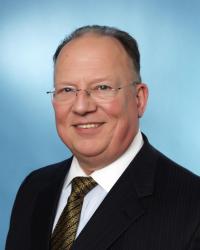UAFS Chancellor says UAFS is ‘well-positioned’ under new education funding formula
by February 15, 2017 4:28 pm 548 views

University of Arkansas at Fort Smith (UAFS) Chancellor Dr. Paul Beran is feeling more at ease with shifting funding formulas that have been a topic of discussion during the 2017 legislative session.
At Wednesday’s (Feb. 15) UAFS Board of Visitors meeting, Beran said he felt the university was “well-positioned” to benefit from the new performance-based model that awards points based on a number of criteria. In December, Beran was optimistic but still of the “devil is in the details” mindset. While he admitted Wednesday that is still the case, he struck a more confident tone, stating UAFS could take “full advantage of this change.”
The state’s formula is now based on numerical enrollment and infrastructure costs. Under this structure, UAFS receives approximately $21 million in state funding and operates on a budget of around $73 million.
“Our focus has been graduating people, getting people jobs. Our impact on the local economy is increasing dramatically every year that we graduate a number of students with a large portion of them staying in this area. They go into business and industry, technology, and all of those different areas,” Beran explained adding that the “other piece of this is that we are very active in making sure that we’re working with the high schools, particularly in the areas of the Western Arkansas Technical Center (WATC) and the kinds of technologies in those particular areas where people are getting one-year certificates and two-year degrees.”
Beran found the university to have a clear, “unimpeded” pathway from two-year degrees to four-year degrees without students losing credit hours along the way. “Also,” he added, “we are working with 14 community colleges to deliver multiple degrees,” such as bachelor of applied science, bachelor of organizational leadership, and criminal justice.

Beran said the formula is a complicated system where the university amasses points for each student.
“So we get points for people who matriculate to us from a community college and get another degree. We get points for students of a high-risk category who we get a certificate for or a two-year degree then possibly a four-year degree. We get points for minority students and students of protected classes. When you consider 63% of our students have (Federal) Pell (Grant) money and compare that with our muscular cousin up the hill (University of Arkansas) where only 20% qualify for Pell, that tells you we’re poised to do well in this particular formula.”
One major advantage of the new system, Beran added, was that the funding formula will not be “embedded in legislation.”
“Right now, we can’t change anything without going to the legislature and having them vote on it. With the way this works, it will create an opportunity for ADHE (the Arkansas Department of Higher Education) to create policies and procedures and implement the formula and universities and colleges will have an opportunity to be partners. If something’s not working right, and you run into unintended consequences, you don’t have to issue changes at the legislative level. It gives ADHE and the individual institutions more authority,” Beran said.
Under House Bill 1209 by Rep. Mark Lowery, R-Maumelle, the new formula would base funding on each institution’s success in advancing students. The model would award funding based on credentials awarded, student progression toward degrees, time to degree, and other factors. More funding would be awarded for students enrolled in math and science and other high-demand majors, as well as students coming from challenging circumstances. Each student would be worth a certain amount of points. Still to be determined is a metric measuring post-completion success. Adjustments will be made for smaller colleges, which have higher administrative expenses, and research universities.
The model would cap across-the-board higher education funding increases or decreases at 2% per year. An institution could lose no more than 2% a year but could gain more. Funding changes would be based on three-year rolling averages. The bill passed the committee easily on a voice vote. Prior to the session, Gov. Asa Hutchinson listed the funding formula as one of his top legislative priorities.
